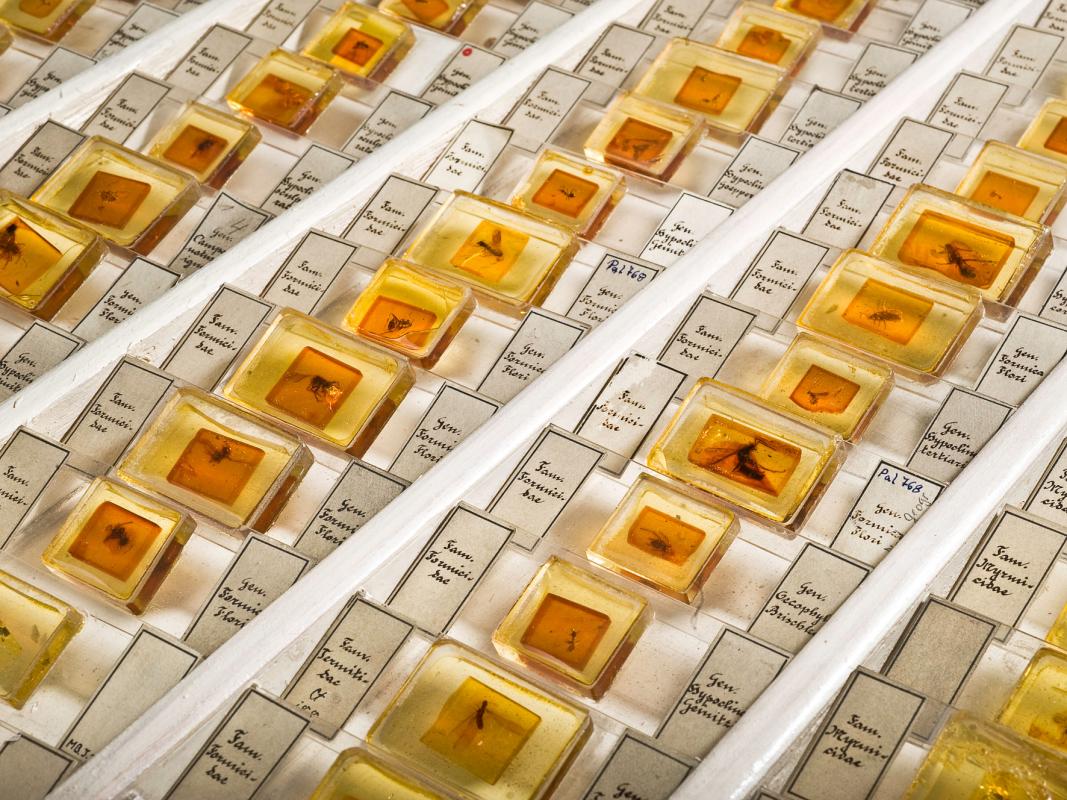Ambers are valuable research objects because they preserve inclusions of ancient plants and animals over millions of years, making it possible to draw conclusions about past ecosystems, as well as current biomes. Researchers from the Museum für Naturkunde Berlin and the American Museum of Natural History New York, in cooperation with five other research institutes from Germany, France and Austria, have published new recommendations in the scientific journal Earth-Science Reviews on how to preserve vulnerable amber collections as a global and scientific heritage for posterity and how to document and study the encased fossils.
Amber is fossil tree resin that was formed millions of years ago and is particularly important because it preserves its plant, insect and arachnid fossil inclusions three-dimensionally and with great fidelity. Both the inclusions and the amber itself are of great interest for research disciplines such as zoology, botany, palaeontology and geochemistry. Amber collections are therefore a valuable scientific, cultural and global heritage. The amber collection held by the Museum für Naturkunde Berlin is being researched and preserved as part of the Future Plan as a global heritage, to which the results of the publication make a current and crucial contribution. The amber collection comprises about 37,000 – 43,000 inclusions and more than 800 first descriptions of fossil arthropod species as well as a large number of plant inclusions.
Despite the exceptional preservation of its inclusions, amber, as an organic material, is very sensitive to a variety of environmental factors such as light, drought or temperature fluctuations. The team led by Dr Eva-Maria Sadowski from the Museum für Naturkunde Berlin and Paul C. Nascimbene from the American Museum of Natural History New York therefore addressed the question of how amber collections can best be preserved while remaining fully accessible for long-term scientific research.
To elucidate these issues, the researchers investigated how decay processes in amber can be detected and which factors cause and accelerate these processes. In addition, they summarized and updated the current state of knowledge and best practices for the conservation and processing of amber and have given specific recommendations on how to treat and preserve amber collections. The authors demonstrate how unfavourable storage conditions can (relatively quickly) cause decay, such as cracking, fracture and colour changes. They also discuss how contact with oils, alcohols and disinfectants as well as other solvents can irrevocably destroy amber and are considered particularly dangerous.
For long-term preservation, the authors advocate storing amber in the dark and at a constant average temperature and humidity. To stabilize the pieces and avoid deterioration caused by oxidation, embedding amber in an artificial resin (a high-grade glass conservation epoxy) is strongly recommended. This review compares past and present common practices and methodologies, weighing the benefits or harm of individual procedures. The authors then present the current state-of-the-art protocols for the preparation and embedding of amber, broken down into individual steps.
In order to make full use of an amber collection and apply it to the modern information and research infrastructure, the digitization of inclusions is indispensable. For this purpose, the authors offer recommendations on the photography of amber specimens and for the microscopic examination of inclusions. "It is important to find a balance between gaining knowledge on the one hand and protecting the amber pieces on the other," says Eva-Maria Sadowski. The application of computed tomography techniques can be a useful alternative to grinding amber pieces to examine inclusions. "Micro-CT images can be used to create 3D models of the inclusions, which can then be sent out as ‘digital loans.’ However, the time and effort required to obtain such images must not be underestimated and conservation measures must always have priority," states Paul C. Nascimbene.
Publication: Sadowski E.-M., Schmidt A.R., Seyfullah L.J., Solórzano-Kraemer M.M., Neumann C., Perrichot V., Hamann C., Milke R., Nascimbene P.C. 2021. Conservation, preparation and imaging of diverse ambers and their inclusions. Earth-Science Reviews.
Pictures for free with the content of the press release
